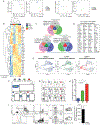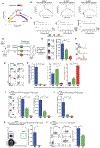Inhibitory signaling sustains a distinct early memory CD8+ T cell precursor that is resistant to DNA damage
- PMID: 33452106
- PMCID: PMC8258400
- DOI: 10.1126/sciimmunol.abe3702
Inhibitory signaling sustains a distinct early memory CD8+ T cell precursor that is resistant to DNA damage
Abstract
The developmental origins of memory T cells remain incompletely understood. During the expansion phase of acute viral infection, we identified a distinct subset of virus-specific CD8+ T cells that possessed distinct characteristics including expression of CD62L, T cell factor 1 (TCF-1), and Eomesodermin; relative quiescence; expression of activation markers; and features of limited effector differentiation. These cells were a quantitatively minor subpopulation of the TCF-1+ pool and exhibited self-renewal, heightened DNA damage surveillance activity, and preferential long-term recall capacity. Despite features of memory and somewhat restrained proliferation during the expansion phase, this subset displayed evidence of stronger TCR signaling than other responding CD8+ T cells, coupled with elevated expression of multiple inhibitory receptors including programmed cell death 1 (PD-1), lymphocyte activating gene 3 (LAG-3), cytotoxic T-lymphocyte-associated protein 4 (CTLA-4), CD5, and CD160. Genetic ablation of PD-1 and LAG-3 compromised the formation of this CD62Lhi TCF-1+ subset and subsequent CD8+ T cell memory. Although central memory phenotype CD8+ T cells were formed in the absence of these cells, subsequent memory CD8+ T cell recall responses were compromised. Together, these results identify an important link between genome integrity maintenance and CD8+ T cell memory. Moreover, the data indicate a role for inhibitory receptors in preserving key memory CD8+ T cell precursors during initial activation and differentiation. Identification of this rare subpopulation within the memory CD8+ T cell precursor pool may help reconcile models of the developmental origin of long-term CD8+ T cell memory.
Copyright © 2021 The Authors, some rights reserved; exclusive licensee American Association for the Advancement of Science. No claim to original U.S. Government Works.
Figures





References
-
- Jacob J, Baltimore D, Modelling T-cell memory by genetic marking of memory T cells in vivo. Nature 399, 593–597. (1999). - PubMed
-
- Opferman JT, Ober BT, Ashton-Rickardt PG, Linear differentiation of cytotoxic effectors into memory T lymphocytes. Science 283, 1745–1748 (1999). - PubMed
-
- Kaech SM, Tan JT, Wherry EJ, Konieczny BT, Surh CD, Ahmed R, Selective expression of the interleukin 7 receptor identifies effector CD8 T cells that give rise to long-lived memory cells. Nat Immunol 4, 1191–1198 (2003). - PubMed
Publication types
MeSH terms
Substances
Grants and funding
- P01 CA210944/CA/NCI NIH HHS/United States
- T32 AI070099/AI/NIAID NIH HHS/United States
- U19 AI117950/AI/NIAID NIH HHS/United States
- T32 CA009140/CA/NCI NIH HHS/United States
- U19 AI149680/AI/NIAID NIH HHS/United States
- U19 AI082630/AI/NIAID NIH HHS/United States
- P01 AI112521/AI/NIAID NIH HHS/United States
- R01 AI115712/AI/NIAID NIH HHS/United States
- P01 AI108545/AI/NIAID NIH HHS/United States
- R01 AI105343/AI/NIAID NIH HHS/United States
- P01 AI056299/AI/NIAID NIH HHS/United States
- T32 DK007191/DK/NIDDK NIH HHS/United States
LinkOut - more resources
Full Text Sources
Other Literature Sources
Medical
Molecular Biology Databases
Research Materials

